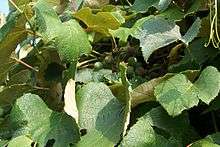Concord grape

The Concord grape is a cultivar derived from the grape species Vitis labrusca (also called fox grape) that are used as table grapes, wine grapes and juice grapes. They are often used to make grape jelly, grape juice, grape pies, grape-flavored soft drinks, and candy. The grape is sometimes used to make wine, particularly kosher wine. Traditionally, most commercially produced Concord wines have been finished sweet, but dry versions are possible if adequate fruit ripeness is achieved.
The skin of a Concord grape is typically dark blue or purple, and often is covered with a lighter-coloured epicuticular wax "bloom" that can be rubbed off. It is a slip-skin variety, meaning that the skin is easily separated from the fruit. Concord grapes have large seeds and are highly aromatic. The Concord grape is particularly prone to the physiological disorder Black leaf.[1]
In the United States 417,800 tons were produced in 2011.[2] The major growing areas are the Finger Lakes District of New York, Lake Erie, Lake Ontario, Southwestern Michigan, and the Yakima Valley in Washington.[3]
Usage
Concord grapes are often used to make grape jelly and are only occasionally available as table grapes,[4] especially in New England. They are the usual grapes used in the jelly for the traditional peanut butter and jelly sandwich, and Concord grape jelly is a staple product in U.S. supermarkets. Concord grapes are used for grape juice, and their distinctive purple color has led to grape-flavored soft drinks and candy being artificially colored purple while methyl anthranilate, a chemical present in Concord grapes, is used to give "grape" flavor. The dark colored Concord juice is used in some churches as a non-alcoholic alternative to wine in the service of communion.[5] Concord grapes have been used to make Kosher wine[6] and sacramental wine. The oldest sacramental winery in America, O-Neh-Da Vineyard, still produces a Concord wine for the altar.[7] Non-toxic sprays that contain methyl anthranilate can be sprayed on the bushes as a cost-effective bird control management. The spray repellent renders the fruit and foliage unpalatable to the birds.[8]
History

The Concord grape was developed in 1849 by Ephraim Wales Bull in Concord, Massachusetts.[9] Bull planted seeds from wild Vitis labrusca and evaluated over 22,000 seedlings before finding what he considered the perfect grape, the original vine of which still grows at his former home. The pollen parent is unknown. Although Concord is frequently considered to be basically a Vitis labrusca cultivar, some have argued that the hermaphrodite flowers suggest at least a small amount of Vitis vinifera in its pedigree. This trait has not been proven to exist in any native American grapes. Recent genetic testing has confirmed that Concord has roughly ⅓ Vitis vinifera parentage.[10] However, Concord is definitely much more labrusca-like in its characteristics than vinifera-like. Many consider the likely male parent to have been Catawba, itself probably half labrusca, which Bull had growing nearby.
In 1853, Bull's grape won first place at the Boston Horticultural Society Exhibition.[9] It was then introduced to the market in 1854. Dr. Thomas Bramwell Welch developed the first Concord grape juice in 1869.[9] Through the process of pasteurization, the juice did not ferment. Welch originally introduced the grape juice to his church, to be used for communion.
Gallery
 A cluster of Concord grapes
A cluster of Concord grapes Ripe grapes (foreground) and unripe grapes (background). Unripe grapes can be made into verjuice.
Ripe grapes (foreground) and unripe grapes (background). Unripe grapes can be made into verjuice. Concord grapes growing on Grape Island, Massachusetts.
Concord grapes growing on Grape Island, Massachusetts.
See also
References
- ↑ R. Irvine & W. Clore The Wine Project pg 31 Sketch Publications 1997 ISBN 0-9650834-9-7
- ↑ "Noncitrus Fruits and Nuts 2011 Summary". United States Department of Agriculture. Retrieved 8 October 2012.
- ↑ "Concord grape". National Grape Association. Retrieved 8 October 2012.
- ↑ "Why can't I find Concord grapes in the grocery store?". Concord Grape Association. Retrieved 8 October 2012.
- ↑ Garrett Peck (3 August 2009). The Prohibition Hangover: Alcohol in America from Demon Rum to Cult Cabernet. Rutgers University Press. p. 180. ISBN 978-0-8135-4849-4.
- ↑ "The 11th Plague? Why People Drink Sweet Wine on Passover". Retrieved 2011-11-04.
- ↑ "O-Neh-Da Authentic Sacramental Wine". O-Neh-Da Vineyard. Retrieved 30 December 2012.
- ↑
- 1 2 3 "The History of the Concord Grape". Concord Grape Association. Concord Grape Association. Retrieved 30 December 2012.
- ↑ Sawler J, Reisch B, Aradhya MK, Prins B, Zhong G-Y, et al. (2013). "Genomics Assisted Ancestry Deconvolution in Grape". PLoS ONE. 8 (11): e80791. doi:10.1371/journal.pone.0080791. PMC 3823699
 . PMID 24244717.
. PMID 24244717.
External links
| Wikimedia Commons has media related to Concord grapes. |